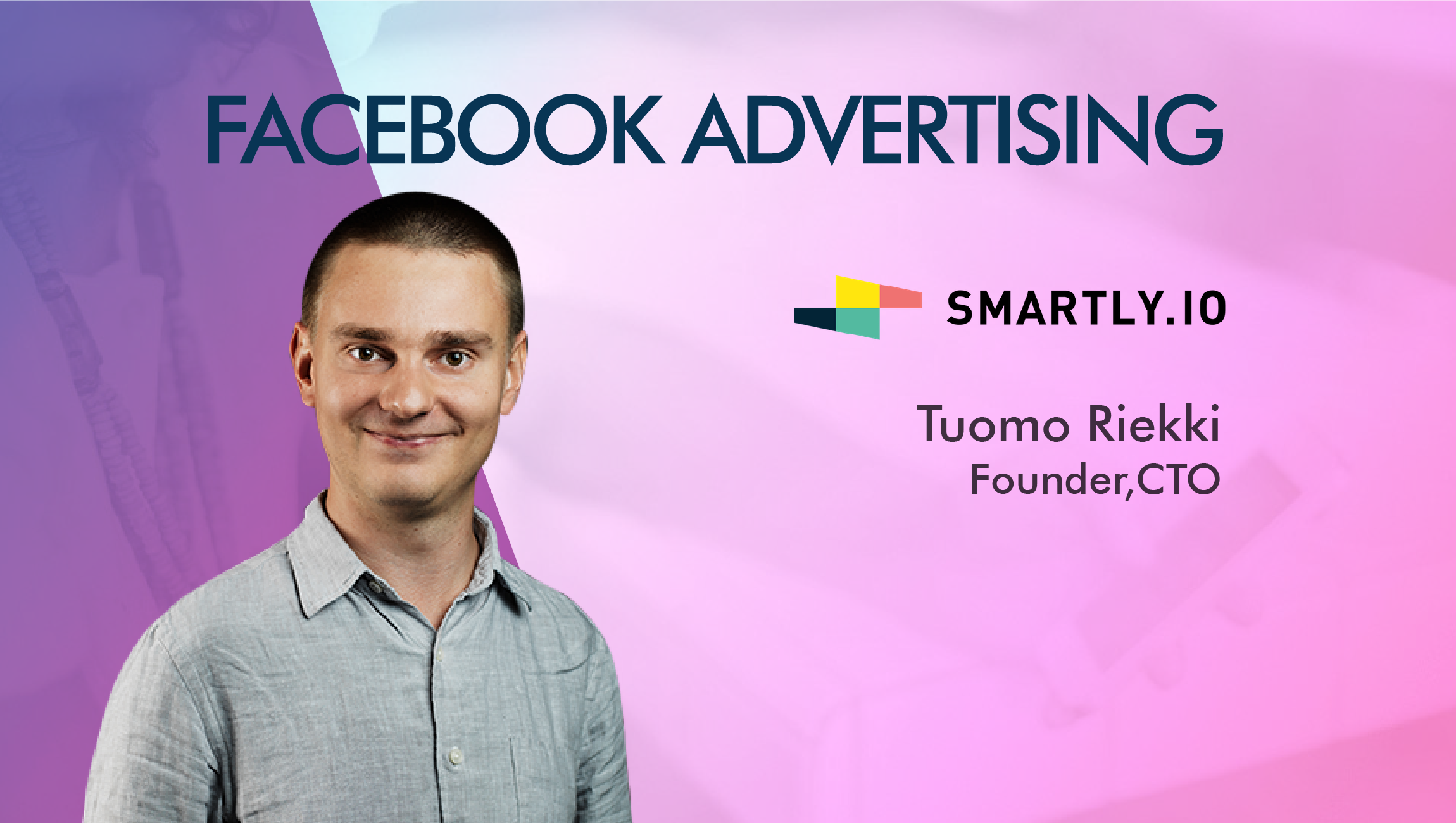Tuomo Riekki
Founder, CTO, Smartly.io
Marketing teams are spending more time and dollars to optimize their Facebook + Instagram marketing performance in 2018. Lack of automation and control in campaign management workflow prevents marketing teams from fully delivering ad campaigns at their highest performance. There is a clear need to differentiate between optimization and automation technologies for Facebook + Instagram Advertising. To throw credible light on Facebook + Instagram Marketing Performance, we spoke to the CTO of Smartly.io, Tuomo Riekki.
Html code here! Replace this with any non empty text and that's it.
Tell us about your role at Smartly.io and the team/ technology you handle.
I am co-founder and CTO at Smartly.io. I spend a majority of my time traveling around the globe to meet with Smartly.io customers and learn about their biggest challenges. I then develop new product initiatives to solve those biggest pain points – sometimes coding new functionalities for them in-person, during my meetings with them. At Smartly.io, working closely with our customers and partners is just as important as working closely with our colleagues – that consistent communication between these groups and our teams yields better results in product and more innovative ideas.
The core foundation of the Smartly.io technology is to help advertisers scale their advertising on Facebook and Instagram. One of the most popular product features is Dynamic Image Templates, which grants advertisers the ability to scale their creatives; it automatically couples product elements like images, price, and product names with a pre-designed template to standardize the design across thousands of ads. You can, for instance, pull best-selling items from product catalogs and create ads that showcase those products.
We work to constantly put customer feedback into action in our offerings. A great example of this is when we realized our customers wanted to have the same scalable options and automation for video advertising that we’ve given them with the image templates. We’re currently developing a video templates feature on our platform to meet those expectations.
How do you differentiate between optimization and automation technologies for Facebook + Instagram Advertising?
Automation is a means of reducing manual work and can be applied to anything from campaign to ad creation and reporting, whereas optimization is a specific task aimed at improving campaign performance.
Our Predictive Budget Allocation is an AI-based feature that helps users to make smarter decisions when it comes to shifting campaign budgets and spend. While it’s an optimization tool, there is also an element of automation in this feature. It automatically works to maximize campaign performance – but it’s done through optimization of budget allocation. All that marketers need to worry about is setting their goal – the technology does the rest, with more insight and smarter allocations than could ever be done manually by a single marketer.
On our platform, we provide marketers with the ability to automate a variety of manual tasks, with the most crucial being creatives through Dynamic Image Templates, as I mentioned previously. That doesn’t mean we take the humans out of the process, we just help marketers scale their work, giving them the ability to hit a larger audience with more relevant advertising. Creative automation capabilities are central to so many of the successes our customers have seen with their Facebook advertising campaigns.
What are the biggest challenges for marketers on Facebook? How does Smartly.io enable marketers on Facebook to beat these challenges?
The biggest challenges tend to be scaling ad campaigns (ie. ramping up spend and advertising volume whilst maintaining performance), targeting the right consumers at the right time, with the right content, of course. There are so many tools via Facebook that can help brands offer more engaging consumer experiences – but targeted advertising at scale is difficult to accomplish without automation capabilities. Manually, it would be challenging to achieve sustainable performance if the bulk of your time is spent on ad and campaign creation and management. FB has a massive user base and many brands have many products or campaigns they want to advertise. Between the two that’s a lot of volume.
At Smartly.io, we have created tools that are able to manage prospecting and retargeting campaigns, end-to-end, while enabling advertisers to scale their creative output. The Smartly.io platform does the work of what might take a really large team – and it does it more efficiently. Our e-commerce and travel customers find our creative automation tools particularly helpful as their product inventory is constantly changing and creatives need to be adjusted accordingly (flight deals adjustment, sold out clothing inventory removed from product ads automatically).
What do the changing algorithms on Facebook mean for marketers and influencers?
With the recent News Feed change, marketers are going to see less organic reach with their branding and advertising on Facebook. Their posts and ad content will not be prioritized, and, as a result, the premium inventory on Facebook will become more expensive and the advertising landscape on Facebook will be more competitive than ever. Having said that, marketers will diversify their ad format portfolio and venture into various placements outside the News Feed: Messenger, Instagram, and Instagram Stories to name a few.
In order to make sure ads stand out, it really comes down to both thoughtful and interactive creative as well as the ability to relay a smart, digital narrative across all stages of the marketing funnel – from brand background to product information. Luckily, Facebook has tools that help advertisers accomplish exactly that. And one of them is a tool that’s actually been around for a while but is not as widely used: the Canvas ad format.
What are the opportunities on Canvas Ads?
Canvas gives advertisers the opportunity to implement legitimate storytelling into their advertising. The format allows for so much flexibility in both the presentation of the ad imagery and in the order of the messaging within it. The Canvas ad can incorporate both higher level branding to direct response messaging about specific products – almost acting like a mobile landing page. It has the ability to scroll vertically and incorporate an abundance of information that we typically can’t fit inside a single ad unit. Compelling brand narratives are going to be the major differentiator between successful and unsuccessful brands. Canvas is definitely a huge stepping stone for that on Facebook.
What are the core tenets of your ‘Digital Transformation’ strategy? How does Smartly.io deliver contemporary Customer Experiences?
The core tenet of our strategy gets right back to that idea I mentioned of keeping our customers close to every step of the process. Their pain points are a consistent source of our latest innovations. So many of our ideas and solutions stem from our customers’ experiences.
Our company structure helps us with our product development speed. That structure includes, of course, that close relationship to the customer, but also lets our employees take direct ownership of their projects. We’re a flat organization structure so it gives everyone more autonomy – which is so critical in the innovation process, giving ideas room to grow and expand.
At Smartly.io, we’re also all consumers, ourselves, so we can literally put ourselves into consumers’ shoes when in the product development stages to understand exactly how our ideas will play out across the digital customer journey – will they create a more seamless and relevant experience for the consumer? That’s always an end goal, in addition to solving our own customers’ specific pain points.
What are your predictions about Social Media intelligence technologies playing a bigger role in 2018? How much of this would be influenced by AI/ML adoption?
Creative automation, particularly around video creatives, will be one of the central technologies in 2018 as personalization and scale are key to succeeding in digital marketing. As for AI, it should not be regarded as a must-have just for the sake of having AI – it only becomes meaningful when it creates value to the marketer by helping them take smarter decisions, faster. Ultimately, AI and machine learning should have the goal of making advertising less of a disruption and more of a value to consumers: seeing what they want, when they want it. In 2018 we’ll continue to develop the machine learning algorithms behind our automated optimization solutions, as well as developing new features that reduce manual work for advertisers and drive ad performance.
Thanks for chatting with us, Tuomo.
Stay tuned for more insights on marketing technologies. To participate in our Tech Bytes program, email us at news@martechseries-67ee47.ingress-bonde.easywp.com











